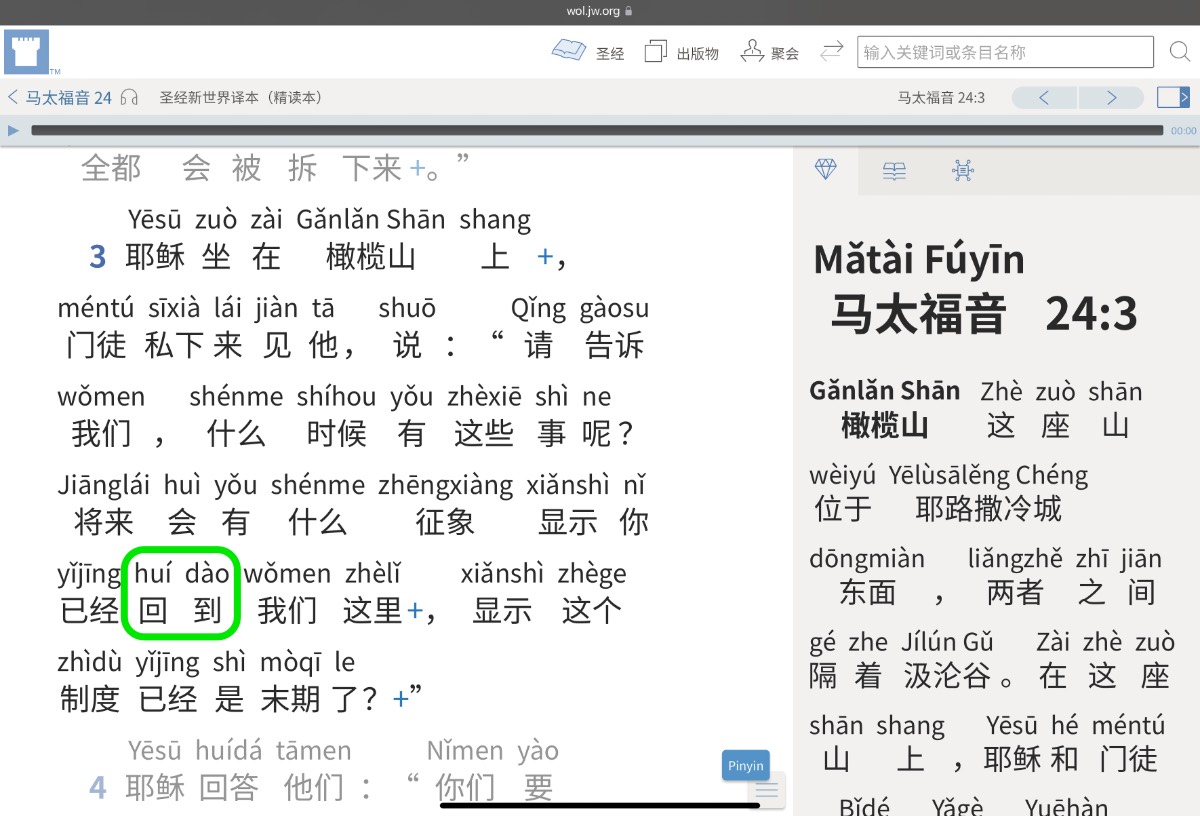huídào (huí·dào {circle back}; return; {go/come back} · {to arrive [at]}; to 回到 回/迴/逥/廻到) ← Tap/click to show/hide the “flashcard”
Appendix A2 of the English New World Translation of the Holy Scriptures (Study Edition), entitled “Features of This Revision”, discusses vocabulary changes that have been made in the current revision, words that have been translated differently than before. As noted in various entries in the excellent resource Referenced Theo. Expressions (RTE), Appendix A2 of the current Mandarin version of the New World Translation Bible (nwtsty) correspondingly discusses words that have been translated differently in the current revision of the Mandarin NWT Bible, compared to how they had been translated before.
Since we base what we say in Jehovah’s service on his Word the Bible, the vocabulary used in it—and the way those vocabulary words are translated—should be reflected in how we speak in our ministry, at our meetings, etc. So, it is beneficial for us Mandarin field language learners to be familiar with the latest thinking from the organization on how Bible terms should be translated into Mandarin.
Mandarin “Presence”
The Greek word pa·rou·siʹa has often been translated less than ideally into English, as the Insight book thus explains:
Many translations vary their renderings of this word. While translating pa·rou·siʹa as “presence” in some texts, they more frequently render it as “coming.” This has been the basis for the expression “second coming” or “second advent” (adventus [“advent” or “coming”] being the Latin Vulgate translation of pa·rou·siʹa at Mt 24:3) with regard to Christ Jesus. While Jesus’ presence of necessity implies his arrival at the place where he is present, the translation of pa·rou·siʹa by “coming” places all the emphasis on the arrival and obscures the subsequent presence that follows the arrival. Though allowing for both “arrival” and “presence” as translations of pa·rou·siʹa, lexicographers generally acknowledge that the presence of the person is the principal idea conveyed by the word.
It is not surprising, then, that attention was paid to how pa·rou·siʹa should be translated into Mandarin for the current Mandarin version of the New World Translation Bible (nwtsty).
The older Mandarin NWT Bible generally translated pa·rou·siʹa as “línzài (lín·zài arriving · {being present} 临在 臨在)”. However, many people find this word to be relatively unfamiliar. So, the current Mandarin version of the NWT Bible (nwtsty) usually translates Christ’s pa·rou·siʹa as “huídào (huí·dào {circling back} · {to arrive at} 回到 回/迴/逥/廻到) wǒmen (wǒ·men us · [pl] 我们 我們) zhèlǐ (zhè·lǐ this · inside → [here] 这里 這裡/裏)”. This should help to avoid unnecessarily obstructing beginning Bible readers from understanding the meanings of scriptures that use pa·rou·siʹa in the original Greek text. At Matthew 24:3, to further clarify the meaning, the current Mandarin version of the NWT Bible (nwtsty) uses the expression “yǐjing (yǐ·jing already · {have gone through} 已经 已經) huídào (huí·dào {circling back} · {to arrive at} 回到 回/迴/逥/廻到)”, to emphasize that it is referring to the situation in which Jesus has already gone through the process of arriving, and thus is present.

Verb-Complement Togetherness
Note that in the scripture in the Watchtower ONLINE LIBRARY linked to above, “huídào (huí·dào {circling back} · {to arrive at} 回到 回/迴/逥/廻到)” is rendered as “huí ({circling back} 回 回/迴/逥/廻) dào ({to arrive at} 到)”, with a space. The post on this blog on “diǎnliàng (diǎn·liàng {dot → [light (v); ignite]} · {to be bright} [→ [illuminate; shine light on]] 点亮 點亮)” discussed such differing renderings:
Getting back to the MEotW “diǎnliàng (diǎn·liàng {dot → [light (v); ignite]} · {to be bright} [→ [illuminate; shine light on]] 点亮 點亮)”, the PRC national standard GB/T 16159-2012 recommends that, being made up of a single-syllable verb and its single-syllable complement, this expression should be written together. Recent official Pīnyīn (Pīn·yīn {Piecing Together} · Sounds → [Pinyin] 拼音) publications such as those on the Watchtower ONLINE LIBRARY often do not follow this recommendation regarding single-syllable verbs and their single-syllable complements, whereas older official Pīnyīn (Pīn·yīn {Piecing Together} · Sounds → [Pinyin] 拼音) publications did follow this recommendation, and as do the unofficial Pīnyīn (Pīn·yīn {Piecing Together} · Sounds → [Pinyin] 拼音) Plus resources.
On the other hand, the unofficial Pīnyīn (Pīn·yīn {Piecing Together} · Sounds → [Pinyin] 拼音) Plus resources join the official Pīnyīn (Pīn·yīn {Piecing Together} · Sounds → [Pinyin] 拼音) publications, old and new, in explicitly indicating tone sandhi for “bù (not 不)” and “yī (one 一)” (e.g., “búzài (bú·zài not · again; further; continuing; anymore 不再)” instead of the standard “bùzài (bù·zài not · again; further; continuing; anymore 不再)”) to make things easier for readers, even though this practice is not included in the GB/T 16159-2012 standard’s recommendations.
In the end, what matters most re how anything is written is not just what is officially recommended or what happens to be popular among changing, imperfect humans. Rather, what matters most is what really works best to accomplish the goal of writing: To communicate to readers. This is especially true when God-honouring and life-saving Bible truths need to be communicated. So, this blog and the other Pīnyīn (Pīn·yīn {Piecing Together} · Sounds → [Pinyin] 拼音) Plus resources will continue to seek to render Pīnyīn (Pīn·yīn {Piecing Together} · Sounds → [Pinyin] 拼音) in ways that maximize how clearly, easily, effectively, and appropriately it communicates with readers.